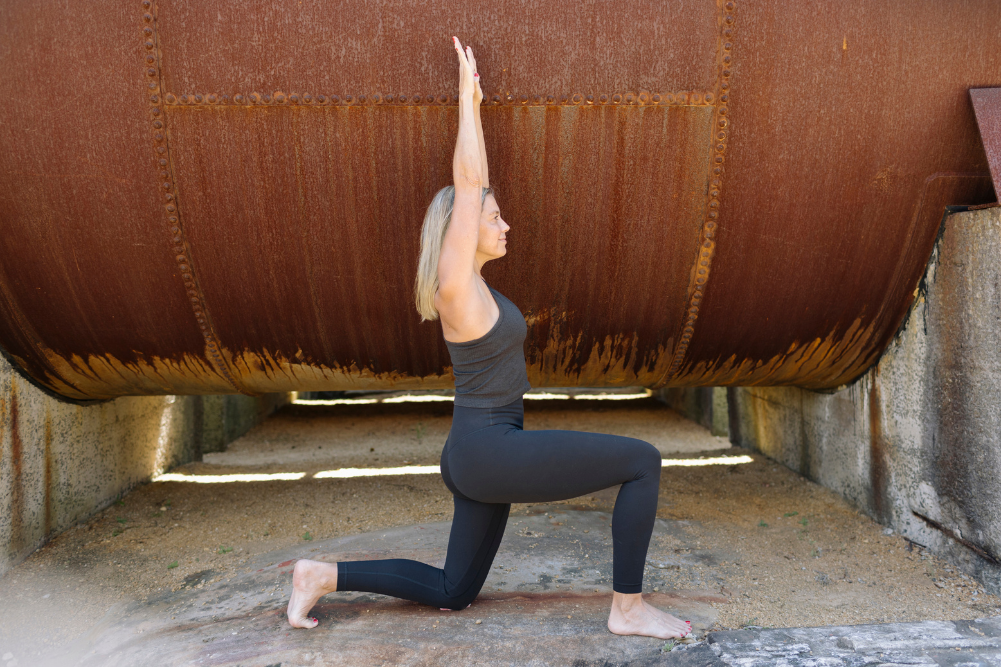Do you have an attitude of gratitude?
In Patanjali’s Yoga Sutras, the second niyama — which outlines personal observances for living spiritually — speaks of santosha, or contentment. Compared to the other yamas (moral disciplines) and niyamas that often sound complex and scary, santosha is slightly more straightforward. Contentment, happiness, joy — sounds great, right?
The thing about santosha, though, is that it’s not just about being content, it’s about practising contentment — both of which can be a real struggle. A lot people associate happiness as something to be gained or to strive for. We think that, once we have a new job, a new Home, a new relationship, then we’ll be happy. Then we’ll be content.
Once you tap into this innate wellspring of joy, you can gain a greater appreciation for what you already have around and within you.
We rarely refer to contentment in the present and, when we do, it’s so often dependent on and attached to something else — a person, an object, an experience — and, once that thing goes, we feel we are lacking or not good enough. We cannot be content without it.
But the thing is, whether you realise it or not, you have everything inside you to experience contentment. And, once you tap into this innate wellspring of joy, you can gain a greater appreciation for what you already have around and within you. As long as we continue to see happiness as something beyond us, we will never be able to achieve it.
Santosha is about cultivating gratitude, practising contentment and accepting the here and now. Contentment isn’t dependent on the past or future, on material objects or anyone else. Being content with what you have, rather than unhappy with what you lack, allows you to rediscover the abundance around you and allows more joy and bliss to enter your life.
The modern challenge
When life is peachy, practising santosha comes naturally. But what about when things are less than great — because, let’s face it, there are some bad things happening in this world and our lives have their own fair share of challenges. Is it selfish to be content in a world of suffering? How can you be content when you fall on tough times?
This is the real challenge of santosha; however, practising contentment can actually help you get through the difficult times. By taking things as they come and making peace with your present circumstances, you can cultivate contentment and gratitude for where you are.
No matter how difficult the road ahead might seem, santosha’s priority is the present — and it is that secret, inner source of happiness, hope and inspiration you can tap into in any moment.
Choosing santosha is an active decision. In life, we often find ourselves in situations where we feel powerless and without any choice. However, you always have the ability to practise santosha if you truly want to. No matter how difficult the road ahead might seem, santosha’s priority is the present — and it is that secret, inner source of happiness, hope and inspiration you can tap into in any moment.
Santosha isn’t about ignoring tough times or complacency. It doesn’t ask you to tolerate bad or dangerous situations you might find yourself in, or forbid you to have ambitions or look toward the future. Rather, it allows you to focus on the present and accept what you are feeling. When we can identify sadness, pain and anger, we also have a clearer concept of happiness, contentment and gratitude.
Practising santosha is a reminder and a learning experience. It teaches us to practise patience and live as best as we can until we can change our circumstances. It grounds us so we can reflect on where we are now — and the goodness around us so we can move forward.
Affirmations for contentment
Affirmations can be practised before yoga, first thing in the morning or even be recited during the day in the times you need to remind yourself to practise contentment.
For an affirmation that focuses on cultivating contentment, consider using some of the below phrases as starting points to create your own. Remember to focus not only on fostering contentment in your life, but within as well.
- I am contentment and happiness
- I am enough
- My happiness is my own
- I appreciate and am grateful for my life as it is
- I accept life’s joys and challenges and learn from these
Why choose gratitude?
Patanjali said that santosha fosters a supreme joy that leads to realisation of the true self. Through the practice of contentment, appreciation and gratitude, you can cultivate this joy that pervades every layer of your being.
Santosha makes each of us more aware and grateful for the goodness around us when we, and others, need it the most — and yogis aren’t the only ones telling us to do this.
Over the years, a range of studies have documented some interesting benefits to overall health and wellbeing that come with practising gratitude, even in the midst of adversity such as confronting death or chronic illness. Cultivating a content and fully present state of mind by practising gratitude provides greater perspective, appreciation for life and can benefit us in other ways, too. Among other benefits, it:
- Contributes to better health. A 2015 paper found those who practise gratitude are more hopeful and physically healthier. Grateful people take better care of their health and exercise more. Another study from 2015 by The University of California, San Diego also found grateful people experienced lower fatigue and depression and increased cardiac function.
- Improves sleep. Replace counting sheep with counting your blessings. A number of different studies, including most recently in the Journal of Health Psychology 2015, found those who practise gratitude sleep better and have lower blood pressure.
- Improves relationships. Unsurprisingly, gratitude reduces aggression and increases empathy. We feel a greater connection and understanding with people as a result, which strengthens and improves relationships.
- Fosters a better outlook. A 2015 study in the Journal of Personality and Individual Differences showed happier and grateful people also experience higher levels of personal wellbeing, greater life satisfaction and lower levels of psychological distress.
Finding contentment through asana
Santosha is something you can actively practise on the yoga mat — but you don’t necessarily need asanas (physical poses) in order to do this.
We have all been guilty of looking around during yoga class to compare other students’ postures to our own, and evaluating if they are “better” or “worse”. But, as long as you keep comparing yourself to others, you’ll never be happy in your practice. Even if you end up doing the most complicated of arm balances without contentment and appreciation, you will never make true progress in your practice.
Your practice is a journey, and contentment, in the here and now, will help pave the path forward in your yogic experience.
Santosha is important to remember on the mat as it teaches an appreciation of where we are in our practice right now. After all, you need to master that shoulder stand before you move on to the headstand and, if you can’t respect your body’s limits, you’ll find it will respond in no uncertain terms. It will prevent you from going further and simply say “no” — or result in a physical injury.
Practising santosha on the mat means appreciating yourself and your practice no matter your level. Santosha requires you to let go of the desire to be stronger or more flexible and accept and become aware of your body and your limits. Your practice is a journey, and contentment, in the here and now, will help pave the path forward in your yogic experience.
How to practise santosha
Santosha is more than smiling all the time; it’s about cultivating an attitude of gratitude. The santosha mindset puts us in the present and allows us to reflect on and appreciate the wonder around and within us and discover true joy. There are lots of ways to cultivate and bring greater awareness of santosha into your life, including:
- Journaling is incredibly cathartic. Use it as a chance to reflect on your day and whether it aligned with your intention of practising santosha. Also consider keeping a gratitude journal or list to actively practise santosha. Begin your day by writing down five things you are grateful for. It might be showing appreciation for a beautiful morning, having a safe journey to work or the support of family and friends. Cultivating contentment by accepting and embracing the present makes us more receptive to the goodness in our lives.
- Affirmation setting. Put together your own affirmations or aphorisms to remind yourself of the goodness around you and to build joy and contentment. See the above list for suggestions. Consider putting these statements around your home or workspace or even in an “appreciation” jar you can pull out at random when you need a reminder to seek out the good you already have in life.
- Yoga and meditation. Consider practising asanas that focus on the heart chakra, expand and open the chest and have an uplifting effect on the body and mind, such as backbends. Meditation and mindfulness also helps cultivate santosha. Meditate on the breath, a mantra or what you are grateful for at that time. By integrating more mindfulness practices into your daily life, you can actively practise santosha. When you stop worrying about the future and dwelling in the past, you can focus on the present without judgement and find contentment in the now.
- Do more of what you love. Find meaningful ways to cultivate more contentment in your life — and do more of it! This could be as simple as spending time with family and friends, giving back to your community or pursuing a hobby or passion.
Emergency santosha tips
Life has its fair share of tricky moments. During these times, it’s understandable to abandon any thought of santosha and get caught up in the dominant emotions you’re feeling, which likely are anger, sadness or hopelessness. Whether it’s your boss piling more work on you when you’re already under the pump, a fight with your partner or even the frustration of waiting in line or in traffic, cultivating santosha through practising acceptance, gratitude and compassion is something that can help you get through those less-than-great moments. Here’s how to do it:
- Take a minute of time-out. Take a few deep breaths and step away if you need to. Allow yourself to breathe and sit with the situation that is troubling you. Allow your thoughts to arise and recognise them as temporary without judging or identifying them.
- Consider what is true. Sometimes a situation is so bad that it is difficult to see a silver lining. Santosha isn’t about covering up what you are experiencing and pretending everything is sunshine and rainbows; santosha allows us to recognise things as they are, to find acceptance and a way to move forward through patience, love and compassion. In these times, use santosha as your sanctuary, your inner hope and peace that will always be inside you to give you solace and support and that cannot be dimmed even in the toughest of times.
- Gain perspective and learn. As difficult as it may seem, be compassionate towards the challenging person or situation. Consider what might be gained from this experience and what can be learned. As a way to gain greater perspective and appreciation, think of others who may be in a similar situation or perhaps worse off, and practise empathy and compassion.
- Go back to you. We are faced with change for better or worse every day. However, the true self is unchanging. Who you really are and always will be is good enough already. Connecting with a higher consciousness and finding silence and contentment within is a reminder that you have everything within you to make you happy, and the strength to carry on.
- Smile from the inside out. When we smile, endorphins are released, which help manage stress. Smile from a place of deep contentment and happiness and radiate that love outwards, even to those who may have wronged you. Smiling is contagious!
Be here now
The wise Chinese philosopher Lao Tzu once said, “Be content with what you have; rejoice in the way things are. When you realise there is nothing lacking, the whole world belongs to you.”
This is the attitude of santosha. It teaches us to embrace patience, acceptance, gratitude and happiness — things that are always within us and can never be dimmed — so that even in difficult times, we can persevere and make it through.
Santosha really comes back to simply living in the now. It’s about accepting what we have, where we are and being content with this. It tells us, don’t sit around and wish and wait for happiness. It is here already and it is within you. So start living and breathing it!








